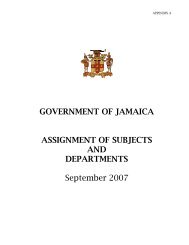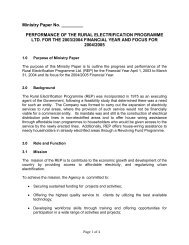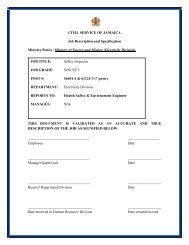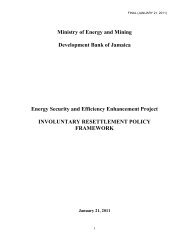Jamaica Biofuels Report - Ministry of Energy
Jamaica Biofuels Report - Ministry of Energy
Jamaica Biofuels Report - Ministry of Energy
You also want an ePaper? Increase the reach of your titles
YUMPU automatically turns print PDFs into web optimized ePapers that Google loves.
5. Processing and Distribution5.1 Technology-neutral processing regime required to activate the desiredbi<strong>of</strong>uel developmentsSugarcane ProcessingThe total amount <strong>of</strong> energy in 1 t <strong>of</strong> cane (aerials part) is about 7400 MJ, more than a barrel <strong>of</strong>oil (6000 MJ), but it is divided about 2400 MJ in sugars, 2500 MJ in the bagasse and 2500 MJ inthe straw (mainly leaves and sometimes called cane trash). The efficiency <strong>of</strong> recovery <strong>of</strong> thesugar, in various final non-energy forms, and the balance as energy differs between each typedue to the process differences. While sugar recovery reaches efficiencies <strong>of</strong> over 90% withcurrent technology, the recovery <strong>of</strong> the energy in terms <strong>of</strong> process steam and electricity byusing the bagasse as a boiler fuel is lower. Whereas modern high-pressure bagasse boilers canachieve thermal efficiencies <strong>of</strong> 85%, older lower pressure units have efficiencies <strong>of</strong>ten below75%. In addition, the overall steam to electricity conversion efficiencies that for modern unitscan exceed 30% is <strong>of</strong>ten lower than 10% at older plants. In order to reduce the cost <strong>of</strong> ethanolproduced from the cane sugar whether in the case <strong>of</strong> a combined granular sugar and ethanolplant or is a purpose built cane to ethanol with no granular sugar plant, the main approachadopted in the last 20 years has been to introduce higher energy efficiency in the processessuch that surplus electricity can be maximized and sold to create additional revenue that can beused to reduce the price <strong>of</strong> the ethanol when this is needed for overall financial viability. Longerterm research, development and initial pre-commercialization <strong>of</strong> advanced bi<strong>of</strong>uel productionprocesses that begin after the hydrolysis <strong>of</strong> the fiber (celluloses and hemicelluloses), <strong>of</strong>fer theprospect <strong>of</strong> an approach that provided better overall returns and will make sugar cane almostunbeatable in terms <strong>of</strong> energy production. This new technology will place greater emphasis ondeveloping varieties <strong>of</strong> cane that may be higher in fiber and or mature earlier or later. It willcertainly increase the needs for well-managed operations in the field as well as in the processto maximize outputs and minimize unit costs.Ethanol production can be built as an extension <strong>of</strong> current sugar mill operations with theaddition primarily <strong>of</strong> fermentation and distillation capabilities, as the dashed section <strong>of</strong> Figure7 shows. Sugarcane processing for ethanol production is a well-established commercialprocess that can be readily purchased and installed <strong>of</strong>f the shelf as a turn-key operation by asmall number <strong>of</strong> international suppliers. As seen in Fig. 7, sugarcane delivered to the plant iscrushed to extract the sugar juice. The sucrose-rich juice is then concentrated and processedto sugar and molasses (for rum production) or fermented by yeast to ethanol in continuousstirred fermentation units. The dilute fermentation broth is directed to a distillation column,where ethanol is recovered as a 95.6% (by weight) aqueous solution. In <strong>Jamaica</strong> the molassesare turned into rum by the country’s spirits industry.The ethanol solution is further refined to anhydrous ethanol using molecular sieves to removethe remaining water. The sieves consist <strong>of</strong> zeolites, which facilitate the separation <strong>of</strong> ethanol39










